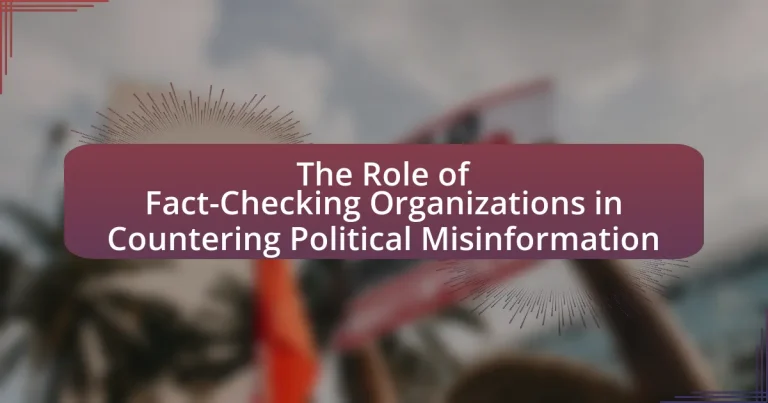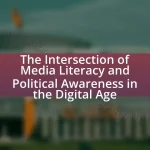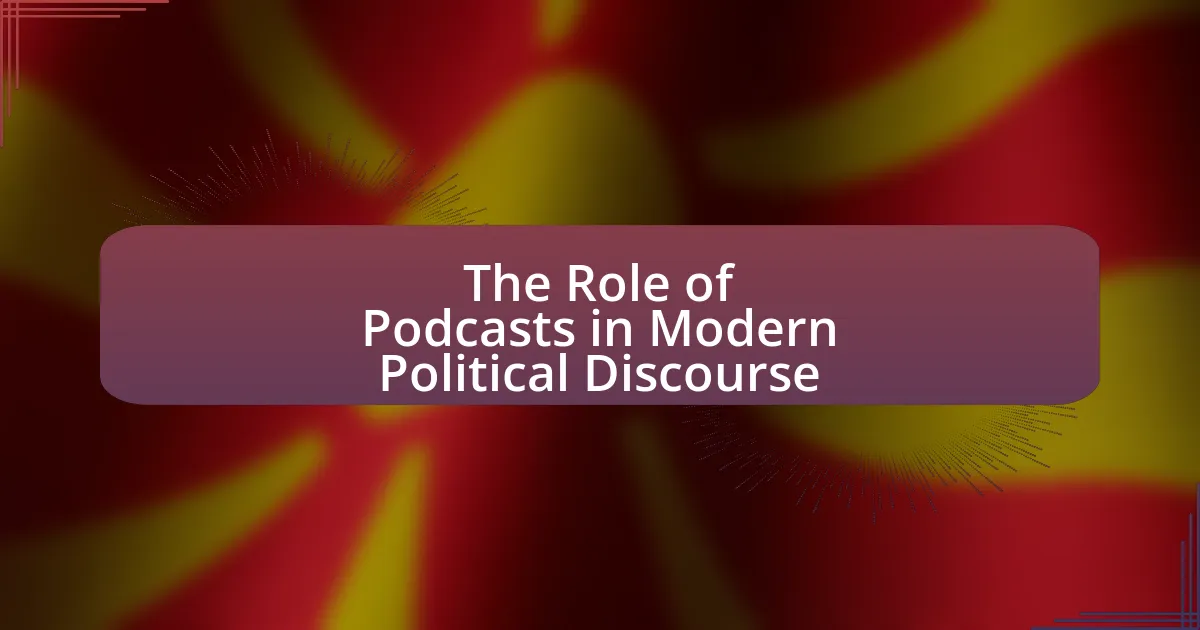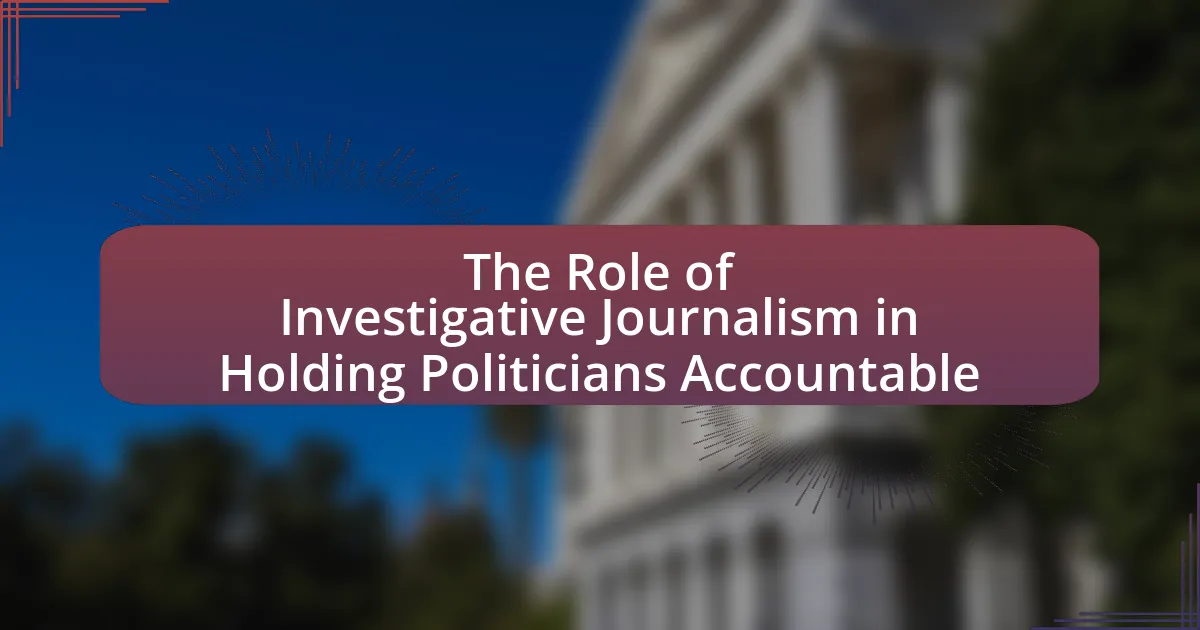Fact-checking organizations play a vital role in combating political misinformation by verifying claims made by public figures and media sources. They employ systematic methodologies to assess the accuracy of statements, utilizing credible sources and expert consultations. The article explores how these organizations identify misinformation, the challenges they face, and the impact of their work on public opinion and informed citizenship. It also discusses the importance of transparency, collaboration, and technology in enhancing the effectiveness of fact-checking efforts, as well as the role individuals can play in supporting these initiatives.
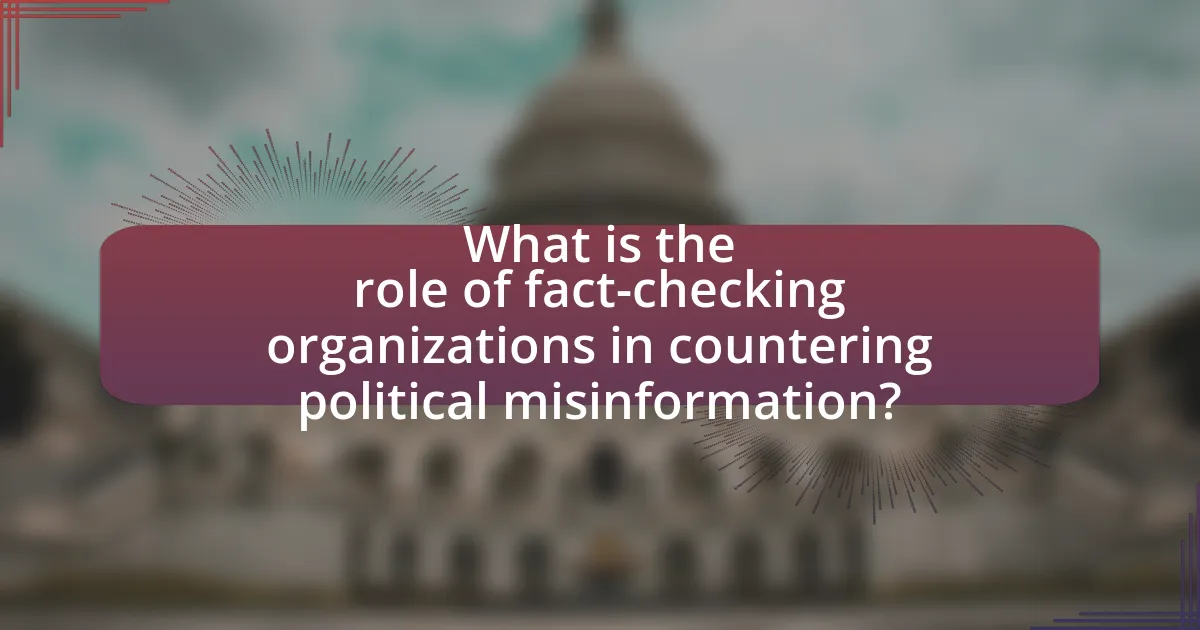
What is the role of fact-checking organizations in countering political misinformation?
Fact-checking organizations play a crucial role in countering political misinformation by verifying claims made by public figures and media sources. These organizations assess the accuracy of statements, providing evidence-based evaluations that help inform the public. For instance, during the 2020 U.S. presidential election, organizations like PolitiFact and FactCheck.org analyzed thousands of claims, revealing that a significant percentage of misinformation was debunked, thus promoting informed decision-making among voters. Their work not only corrects falsehoods but also enhances public trust in credible information sources, contributing to a more informed electorate.
How do fact-checking organizations identify political misinformation?
Fact-checking organizations identify political misinformation through a systematic process that includes verifying claims against credible sources, analyzing the context of statements, and utilizing fact-checking databases. They often employ trained researchers who assess the accuracy of information by cross-referencing it with reliable data, such as government reports, academic studies, and expert opinions. For instance, organizations like PolitiFact and FactCheck.org utilize a rating system to evaluate the truthfulness of statements made by public figures, providing transparency in their methodology. This rigorous approach helps ensure that the identification of misinformation is based on factual evidence and established standards of verification.
What methodologies do fact-checking organizations use for verification?
Fact-checking organizations use a variety of methodologies for verification, including source evaluation, cross-referencing, and expert consultation. Source evaluation involves assessing the credibility of the information’s origin, while cross-referencing entails comparing claims against multiple reliable sources to confirm accuracy. Expert consultation is utilized to gain insights from specialists in relevant fields, ensuring that the context and nuances of the claims are accurately understood. These methodologies are essential for maintaining the integrity of the fact-checking process and effectively countering political misinformation.
How do fact-checkers assess the credibility of sources?
Fact-checkers assess the credibility of sources by evaluating several key criteria, including the source’s expertise, reputation, and the presence of corroborating evidence. They analyze the author’s qualifications, the publication’s history, and whether the information aligns with established facts. For instance, a study by the Pew Research Center found that 64% of Americans believe that fact-checking organizations help clarify the accuracy of information, indicating the importance of credibility assessment in public perception. Additionally, fact-checkers often cross-reference claims with reliable databases and expert opinions to ensure accuracy, further reinforcing the credibility of the sources they utilize.
Why are fact-checking organizations important in today’s political landscape?
Fact-checking organizations are crucial in today’s political landscape because they help ensure the accuracy of information disseminated to the public. In an era marked by rapid information sharing and the prevalence of misinformation, these organizations verify claims made by politicians and media outlets, thereby promoting accountability. For instance, a study by the Pew Research Center found that 64% of Americans believe that fact-checking helps them understand the truth behind political statements. By providing evidence-based assessments, fact-checking organizations empower citizens to make informed decisions, ultimately strengthening democratic processes.
What impact does misinformation have on public opinion?
Misinformation significantly distorts public opinion by shaping beliefs and attitudes based on false or misleading information. Studies indicate that exposure to misinformation can lead to the formation of incorrect perceptions about political issues, candidates, and policies, ultimately influencing voting behavior and public discourse. For instance, research published in the journal “Science” found that misinformation can persist in public belief even after being debunked, demonstrating its lasting impact on opinion formation. This distortion is exacerbated by social media platforms, where misinformation spreads rapidly, further entrenching false narratives within communities.
How do fact-checking organizations contribute to informed citizenship?
Fact-checking organizations contribute to informed citizenship by verifying claims made by public figures and media, thereby providing citizens with accurate information. These organizations analyze statements and reports, often using evidence-based methodologies, to assess their truthfulness. For instance, a study by the Pew Research Center found that 62% of Americans believe fact-checking helps them understand the news better. By promoting transparency and accountability, fact-checking organizations empower citizens to make informed decisions, engage in meaningful discussions, and participate actively in democratic processes.
What challenges do fact-checking organizations face?
Fact-checking organizations face several significant challenges, including the rapid spread of misinformation, limited resources, and public skepticism. The fast-paced nature of social media allows false information to circulate widely before fact-checkers can respond, making it difficult to counteract effectively. Additionally, many fact-checking organizations operate with limited funding and personnel, which constrains their ability to investigate and verify claims thoroughly. Public skepticism towards fact-checking efforts can further complicate their work, as individuals may dismiss fact-checks that contradict their beliefs. These challenges hinder the overall effectiveness of fact-checking organizations in combating political misinformation.
How do biases affect the work of fact-checkers?
Biases can significantly impact the work of fact-checkers by influencing their judgment and the selection of information they choose to verify. When fact-checkers hold personal or organizational biases, they may prioritize certain narratives or sources over others, leading to a skewed representation of facts. Research indicates that cognitive biases, such as confirmation bias, can cause fact-checkers to favor information that aligns with their pre-existing beliefs, potentially undermining the objectivity required for accurate fact-checking. A study published in the journal “Political Communication” by researchers at the University of California found that fact-checkers’ political affiliations can affect their assessments of claims, demonstrating that biases can compromise the integrity of the fact-checking process.
What are the limitations of fact-checking in combating misinformation?
Fact-checking has several limitations in combating misinformation, primarily due to its reliance on public awareness and engagement. Many individuals remain unaware of fact-checking resources or choose not to consult them, leading to a lack of impact on their beliefs. Additionally, fact-checking often addresses misinformation after it has already spread, making it difficult to counteract the initial influence on public opinion. Research indicates that misinformation can persist even after being debunked, as individuals may cling to false beliefs due to cognitive biases, such as confirmation bias. Furthermore, the sheer volume of misinformation generated, especially on social media platforms, overwhelms fact-checking organizations, limiting their ability to address every claim effectively. These factors collectively hinder the effectiveness of fact-checking in mitigating the spread and impact of misinformation.

How do fact-checking organizations operate?
Fact-checking organizations operate by systematically verifying claims made in public discourse, particularly in political contexts. They employ a structured process that includes researching the claim, consulting credible sources, and analyzing evidence to determine the accuracy of the information. For instance, organizations like PolitiFact and FactCheck.org utilize a rating system to categorize claims as true, false, or misleading, providing transparency in their evaluations. This method is supported by rigorous standards for sourcing and methodology, ensuring that their findings are reliable and can be replicated. Additionally, many fact-checking organizations publish their methodologies and sources, which enhances their credibility and allows the public to understand how conclusions are reached.
What processes do fact-checking organizations follow?
Fact-checking organizations follow a systematic process that typically includes research, verification, and publication. Initially, they identify claims that require verification, often sourced from media reports, social media, or public statements. Next, they conduct thorough research, which involves gathering evidence from credible sources, consulting experts, and cross-referencing information. After verifying the accuracy of the claim, they categorize the findings, often using a rating system to indicate the truthfulness of the statement. Finally, they publish their findings on their platforms, providing detailed explanations and sources to support their conclusions. This structured approach ensures transparency and accountability in countering misinformation.
How do fact-checkers prioritize which claims to investigate?
Fact-checkers prioritize claims to investigate based on factors such as the potential impact of the misinformation, the prominence of the claim, and the likelihood of it spreading. High-profile claims that could influence public opinion or policy decisions are prioritized, as are claims made by influential figures or widely circulated on social media. For instance, a study by the Pew Research Center found that misinformation related to elections and public health is often prioritized due to its significant societal implications. This systematic approach ensures that fact-checkers address the most pressing issues affecting public discourse.
What role does technology play in the fact-checking process?
Technology plays a crucial role in the fact-checking process by enabling faster verification of information and enhancing the accuracy of assessments. Automated tools, such as natural language processing algorithms and machine learning models, analyze large volumes of data to identify misinformation patterns and flag potentially false claims. For instance, platforms like ClaimBuster utilize AI to evaluate statements in real-time, providing fact-checkers with immediate insights. Additionally, technology facilitates collaboration among fact-checking organizations by allowing them to share databases and resources, thereby improving the overall efficiency and effectiveness of the fact-checking process.
How do fact-checking organizations communicate their findings?
Fact-checking organizations communicate their findings primarily through published reports, articles, and social media platforms. These organizations often create detailed analyses that assess the accuracy of claims made by public figures or media outlets, presenting their conclusions alongside evidence and sources. For instance, organizations like PolitiFact and FactCheck.org utilize their websites to publish comprehensive fact-checks that include ratings of truthfulness, explanations of the context, and links to original sources. Additionally, they leverage social media to disseminate their findings quickly, reaching a broader audience and encouraging public engagement with the information. This multi-channel approach ensures that their findings are accessible and can effectively counter misinformation in the political landscape.
What formats do fact-checking organizations use to present information?
Fact-checking organizations present information primarily through written articles, infographics, videos, and social media posts. Written articles typically include detailed analyses of claims, sources, and evidence, while infographics visually summarize key points for easier comprehension. Videos often provide a dynamic explanation of the fact-checking process or the context of the claims being evaluated. Social media posts serve to quickly disseminate findings and engage with a broader audience, often linking back to more comprehensive articles. These formats are designed to enhance accessibility and understanding of complex information, thereby effectively countering political misinformation.
How do fact-checkers engage with the public and media?
Fact-checkers engage with the public and media primarily through transparency, collaboration, and education. They publish findings on various platforms, including websites and social media, to inform the public about misinformation. For instance, organizations like PolitiFact and FactCheck.org provide accessible reports that clarify the accuracy of political statements, thereby fostering informed discourse. Additionally, fact-checkers often collaborate with journalists to enhance reporting accuracy, as seen in partnerships with news outlets to fact-check claims in real-time during political events. This engagement not only helps to debunk falsehoods but also builds trust in the fact-checking process, as evidenced by studies showing that audiences are more likely to trust information from transparent sources.
What partnerships do fact-checking organizations form?
Fact-checking organizations form partnerships with media outlets, academic institutions, technology companies, and non-profit organizations to enhance their credibility and reach. These collaborations allow fact-checkers to access resources, share data, and amplify their findings. For instance, partnerships with media outlets enable fact-checkers to publish their work widely, while collaborations with technology companies can facilitate the integration of fact-checking tools into social media platforms, helping to combat misinformation in real-time. Additionally, alliances with academic institutions often provide research support and validation, reinforcing the accuracy of their claims.
How do collaborations enhance the effectiveness of fact-checking?
Collaborations enhance the effectiveness of fact-checking by pooling resources, expertise, and networks among various organizations. When fact-checking entities collaborate, they can share data, methodologies, and best practices, which leads to more comprehensive and accurate assessments of information. For instance, partnerships between fact-checkers and academic institutions can leverage research capabilities to analyze misinformation trends more effectively. Additionally, collaborative efforts can amplify outreach, ensuring that fact-checked information reaches a broader audience, thereby increasing public awareness and trust. Studies have shown that collaborative fact-checking initiatives, such as those seen in the International Fact-Checking Network, have led to improved accuracy rates and greater impact in countering misinformation.
What role do social media platforms play in supporting fact-checkers?
Social media platforms play a crucial role in supporting fact-checkers by providing them with access to a vast amount of user-generated content that requires verification. These platforms facilitate the dissemination of fact-checking resources and tools, enabling fact-checkers to identify and address misinformation rapidly. For instance, platforms like Facebook and Twitter have partnered with independent fact-checking organizations to flag false information and direct users to verified sources, thereby enhancing the visibility of accurate information. Additionally, social media algorithms can prioritize fact-checked content, ensuring that users encounter reliable information more frequently. This collaborative approach is vital in combating the spread of political misinformation, as evidenced by initiatives such as the International Fact-Checking Network’s Code of Principles, which many social media companies adhere to in their efforts to promote transparency and accountability in information sharing.
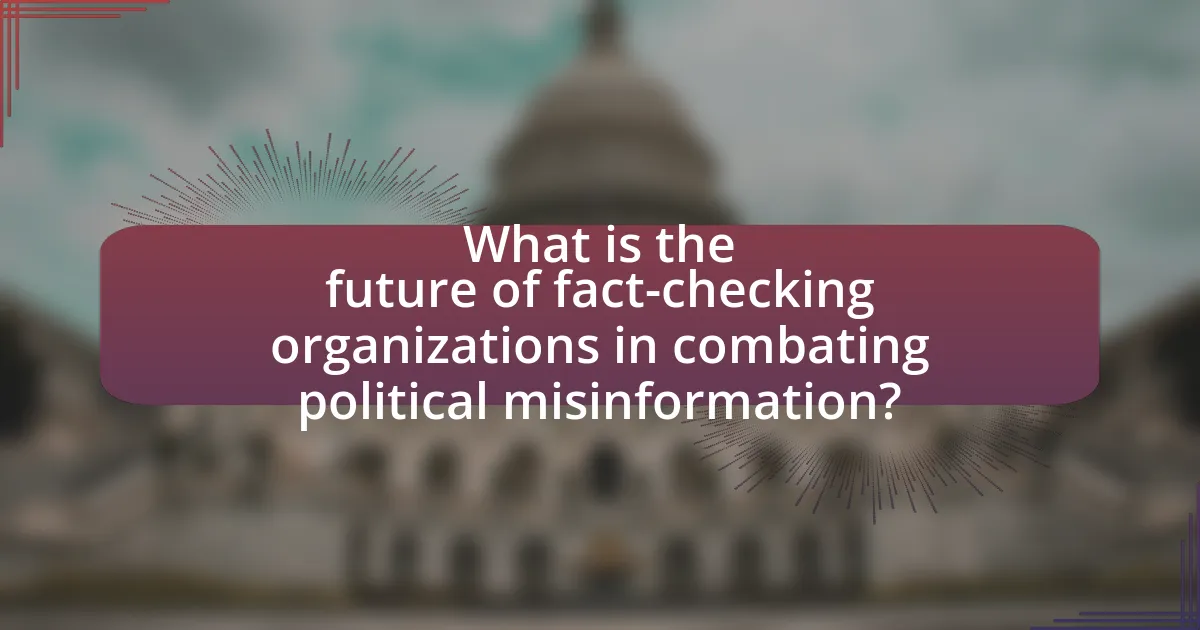
What is the future of fact-checking organizations in combating political misinformation?
The future of fact-checking organizations in combating political misinformation is likely to involve increased collaboration with technology platforms and enhanced use of artificial intelligence. As misinformation spreads rapidly through social media, fact-checking organizations will need to adapt by leveraging AI tools to identify and verify claims more efficiently. For instance, a study by the Pew Research Center indicates that 64% of Americans believe that fact-checking can help reduce misinformation, highlighting the growing public reliance on these organizations. Furthermore, partnerships with social media companies can facilitate real-time fact-checking, allowing organizations to address misinformation as it emerges. This proactive approach will be essential in maintaining credibility and effectiveness in the face of evolving misinformation tactics.
How are fact-checking organizations adapting to new challenges?
Fact-checking organizations are adapting to new challenges by employing advanced technology and collaborative strategies to enhance their effectiveness. These organizations are increasingly utilizing artificial intelligence and machine learning tools to quickly identify and analyze misinformation across various platforms, allowing them to respond more rapidly to emerging false narratives. For instance, the International Fact-Checking Network reported that many organizations are now integrating automated systems to flag potential misinformation, which significantly reduces the time required for human verification. Additionally, fact-checkers are forming partnerships with social media companies to improve the visibility of their work and ensure that accurate information reaches wider audiences. This collaborative approach has been shown to increase the impact of fact-checking efforts, as evidenced by studies indicating that users are more likely to trust information that is corroborated by multiple reputable sources.
What innovations are emerging in the field of fact-checking?
Innovations in the field of fact-checking include the use of artificial intelligence and machine learning algorithms to automate the verification process. These technologies enable fact-checkers to analyze large volumes of data quickly, identifying patterns and flagging potential misinformation more efficiently. For instance, platforms like ClaimBuster utilize AI to assess the veracity of statements made in public discourse, providing real-time fact-checking capabilities. Additionally, collaborative databases and crowdsourced fact-checking initiatives, such as those seen in platforms like PolitiFact and Snopes, enhance the accuracy and reach of fact-checking efforts by pooling resources and expertise from various organizations. These innovations are crucial in addressing the rapid spread of misinformation, particularly in political contexts, where timely and accurate information is essential for informed public discourse.
How can fact-checkers improve their outreach and impact?
Fact-checkers can improve their outreach and impact by leveraging social media platforms to disseminate accurate information rapidly and engaging with diverse audiences. By utilizing platforms like Twitter and Facebook, fact-checkers can reach a broader demographic, ensuring that their findings are accessible to various segments of the population. Research indicates that social media is a primary source of news for many individuals, with 53% of U.S. adults reporting they often get news from social media (Pew Research Center, 2021). Additionally, collaborating with influencers and community leaders can amplify their messages, making fact-checking efforts more relatable and trustworthy. This approach not only enhances visibility but also fosters a community of informed individuals who can critically assess misinformation.
What best practices can fact-checking organizations adopt?
Fact-checking organizations can adopt best practices such as establishing clear methodologies, ensuring transparency in their processes, and collaborating with other organizations. Clear methodologies allow fact-checkers to maintain consistency and credibility in their evaluations, as seen in the International Fact-Checking Network’s Code of Principles, which emphasizes accuracy and fairness. Transparency in processes, including disclosing sources and decision-making criteria, builds trust with the public and enhances accountability. Collaboration with other organizations can amplify efforts and share resources, as demonstrated by partnerships between various fact-checking entities during major events like elections, which help to address misinformation more effectively.
How can fact-checkers enhance transparency and accountability?
Fact-checkers enhance transparency and accountability by systematically verifying claims made by public figures and media outlets, thereby providing accurate information to the public. This process involves rigorous methodologies, such as cross-referencing sources and utilizing expert opinions, which help to clarify the truth behind statements. For instance, organizations like PolitiFact and FactCheck.org have established standards for transparency by disclosing their sources and methodologies, allowing audiences to understand how conclusions are reached. This practice not only holds individuals and institutions accountable for misinformation but also fosters a more informed citizenry, as evidenced by studies showing that fact-checking can reduce the spread of false information in political discourse.
What strategies can be implemented to educate the public about misinformation?
Implementing educational strategies to combat misinformation involves utilizing fact-checking organizations to provide accurate information, promote media literacy, and engage in community outreach. Fact-checking organizations, such as Snopes and PolitiFact, actively verify claims and disseminate their findings to the public, thereby fostering a culture of critical thinking. Research indicates that media literacy programs can significantly enhance individuals’ ability to discern credible information from falsehoods, as evidenced by a study published in the Journal of Media Literacy Education, which found that participants in such programs improved their critical evaluation skills by 30%. Additionally, community outreach initiatives, including workshops and seminars, can effectively raise awareness about misinformation and its impact, as demonstrated by the success of the News Literacy Project, which has reached over 1.5 million students and educators. These strategies collectively empower the public to recognize and challenge misinformation.
What role can individuals play in supporting fact-checking efforts?
Individuals can support fact-checking efforts by actively verifying information before sharing it. This includes cross-referencing claims with reputable sources, utilizing fact-checking websites, and reporting misinformation to relevant platforms. Research indicates that when individuals engage in these practices, they contribute to a more informed public discourse and help reduce the spread of false information. For instance, a study by the Pew Research Center found that 64% of social media users have encountered misinformation, highlighting the importance of individual vigilance in combating it.
How can citizens contribute to the fight against misinformation?
Citizens can contribute to the fight against misinformation by actively verifying information before sharing it. This involves checking facts through reliable sources, such as established news organizations or fact-checking websites like Snopes or FactCheck.org. Research indicates that misinformation spreads rapidly on social media, with a study by MIT showing that false news stories are 70% more likely to be retweeted than true stories. By prioritizing accuracy and sharing verified information, citizens can help reduce the spread of false narratives and promote informed discourse.
What resources are available for individuals to verify information?
Individuals can verify information using resources such as fact-checking websites, academic databases, and government publications. Fact-checking organizations like Snopes, FactCheck.org, and PolitiFact provide evidence-based assessments of claims and news stories, helping users discern factual accuracy. Academic databases, including Google Scholar and JSTOR, offer access to peer-reviewed research and studies that can substantiate or refute various claims. Additionally, government publications and official statistics from agencies like the U.S. Census Bureau or the World Health Organization provide reliable data that can be used to verify information. These resources collectively empower individuals to critically evaluate the credibility of information they encounter.
